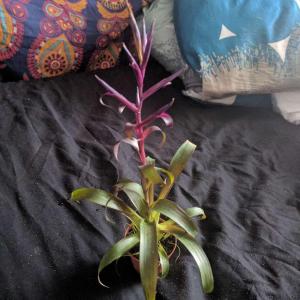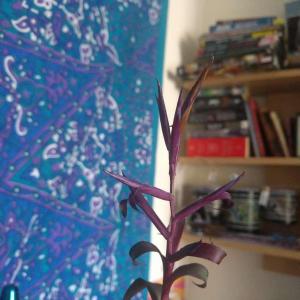求助
hege
2017年10月11日

need some help identifying this one #Identification #help #air-plant #epiphytes




0
0
Infinte Blossom:Purple heart
文章
Dummer. ゛☀
2017年10月01日

Scientific Name
Kalanchoe pinnata (Lam.) Pers.
Common Names
Air Plant, Cathedral Bells, Life Plant, Miracle Leaf, Goethe Plant, Curtain Plant, Floppers, Good Luck Leaf, Mexican Love Plant, Mother in Law
Synonyms
Cotyledon pinnata (basionym), Bryophyllum calycinum, Bryophyllum pinnatum, Crassula pinnata
Scientific Classification
Family: Crassulaceae
Subfamily: Sedoideae
Tribe: Kalanchoeae
Genus: Kalanchoe
Description
Kalanchoe pinnata is an erect succulent, glabrous herb, up to 5 feet (1.2 m) tall. The stems are hollow, fleshy and dark green. Leaves are scalloped and red along margins. Flowers are bell‐like, reddish-purple, pendent, in large spreading panicles with opposite stout branches.
How to Grow and Care
Kalanchoes are not particularly hard to grow, and the flowering varieties are highly rewarding for their colorful and long-lasting flowers. Many people discard the plants after the bloom is over, but this isn’t really necessary. Simply cut off the flowering head, let the plant rest with reduced water, and resume its normal care. It should flower naturally in spring. Professional growers force Kalanchoes to bloom throughout the year (they are a short-day plant).
The two pendant Kalanchoes make excellent hanging plants. They prefer bright, sunny locations, especially in the summer growing season. During the winter, consider a south-facing window. Water moderately throughout the summer and reduce watering in the winter. Let the soil surface dry out between waterings, and in the winter, the plant can almost dry out.
Kalanchoe pinnata (Lam.) Pers.

Common Names
Air Plant, Cathedral Bells, Life Plant, Miracle Leaf, Goethe Plant, Curtain Plant, Floppers, Good Luck Leaf, Mexican Love Plant, Mother in Law
Synonyms
Cotyledon pinnata (basionym), Bryophyllum calycinum, Bryophyllum pinnatum, Crassula pinnata

Scientific Classification
Family: Crassulaceae
Subfamily: Sedoideae
Tribe: Kalanchoeae
Genus: Kalanchoe

Description
Kalanchoe pinnata is an erect succulent, glabrous herb, up to 5 feet (1.2 m) tall. The stems are hollow, fleshy and dark green. Leaves are scalloped and red along margins. Flowers are bell‐like, reddish-purple, pendent, in large spreading panicles with opposite stout branches.

How to Grow and Care
Kalanchoes are not particularly hard to grow, and the flowering varieties are highly rewarding for their colorful and long-lasting flowers. Many people discard the plants after the bloom is over, but this isn’t really necessary. Simply cut off the flowering head, let the plant rest with reduced water, and resume its normal care. It should flower naturally in spring. Professional growers force Kalanchoes to bloom throughout the year (they are a short-day plant).

The two pendant Kalanchoes make excellent hanging plants. They prefer bright, sunny locations, especially in the summer growing season. During the winter, consider a south-facing window. Water moderately throughout the summer and reduce watering in the winter. Let the soil surface dry out between waterings, and in the winter, the plant can almost dry out.
0
0
文章
Dummer. ゛☀
2017年09月26日

Scientific Name
Tillandsia stricta Sol. ex Ker Gawl.

Common Names
Upright Air Plant, Air Plant, Strict Tillandsia, Erect Tillandsia
Synonyms
Tillandsia stricta var. stricta, Anoplophytum bicolor, Anoplophytum krameri, Anoplophytum strictum, Tillandsia conspersa, Tillandsia krameri, Tillandsia langsdorffii, Tillandsia pulchella var. rosea, Tillandsia rosea
Scientific Classification
Family: Bromeliaceae
Subfamily: Tillandsioideae
Genus: Tillandsia

Flower
Color: Bright red or bright rose
Bloom Time: Early summer
Description
Tillandsia stricta is an evergreen, clump-forming, short-stemmed, perennial with leaves arranged into thick rosettes that grows epiphytically. It is a medium size species up to 4 inches (10 cm) across and up to 8 inches (20 cm) high. The leaves are recurved and covered with a kind of frost like scales, lanceolate, pointed, longer than the scape and grows a bright red or bright rose spike with bright blue flowers. The spike is first held upright but then droops as it lengthens.

How to Grow and Care
Like with most plants, the first step in learning how to grow an Air Plant is learning about their natural habitats. These plants are native to forests and mountains in Central and South America, and the southern United States.
From late-summer to mid-spring, water your Air Plants by misting them daily. Unlike potted houseplants, you can’t really over-water an Air Plant.
Keep in mind that these plants primarily come from warm and humid environments. If you live in a dry climate or have forced air, you will need to provided adequate humidity by regularly misting your Air Plants.
A bright, sunny window, alcove or porch where the Air Plant gets some protection from full sun is ideal for these plants. Remember, they grow in tree canopies and mountains where they get dabbled light and some shade. Too much direct sunlight will lead to your plant drying out or the leaves burning. Yes, plants can get sunburns just like we do.
Origin
Native to South America and Trinidad.
Tillandsia stricta Sol. ex Ker Gawl.

Common Names
Upright Air Plant, Air Plant, Strict Tillandsia, Erect Tillandsia
Synonyms
Tillandsia stricta var. stricta, Anoplophytum bicolor, Anoplophytum krameri, Anoplophytum strictum, Tillandsia conspersa, Tillandsia krameri, Tillandsia langsdorffii, Tillandsia pulchella var. rosea, Tillandsia rosea
Scientific Classification
Family: Bromeliaceae
Subfamily: Tillandsioideae
Genus: Tillandsia

Flower
Color: Bright red or bright rose
Bloom Time: Early summer
Description
Tillandsia stricta is an evergreen, clump-forming, short-stemmed, perennial with leaves arranged into thick rosettes that grows epiphytically. It is a medium size species up to 4 inches (10 cm) across and up to 8 inches (20 cm) high. The leaves are recurved and covered with a kind of frost like scales, lanceolate, pointed, longer than the scape and grows a bright red or bright rose spike with bright blue flowers. The spike is first held upright but then droops as it lengthens.

How to Grow and Care
Like with most plants, the first step in learning how to grow an Air Plant is learning about their natural habitats. These plants are native to forests and mountains in Central and South America, and the southern United States.
From late-summer to mid-spring, water your Air Plants by misting them daily. Unlike potted houseplants, you can’t really over-water an Air Plant.
Keep in mind that these plants primarily come from warm and humid environments. If you live in a dry climate or have forced air, you will need to provided adequate humidity by regularly misting your Air Plants.
A bright, sunny window, alcove or porch where the Air Plant gets some protection from full sun is ideal for these plants. Remember, they grow in tree canopies and mountains where they get dabbled light and some shade. Too much direct sunlight will lead to your plant drying out or the leaves burning. Yes, plants can get sunburns just like we do.
Origin
Native to South America and Trinidad.
2
2
文章
Dummer. ゛☀
2017年09月26日

Scientific Name
Tillandsia harrisii Ehlers

Common Names
Air Plant
Scientific Classification
Family: Bromeliaceae
Subfamily: Tillandsioideae
Genus: Tillandsia

Flower
Color: Orange to red floral bracts and blue-violet petals
Bloom Time: Indeterminate
Description
Tillandsia harrisii is a very unique looking air plant up to 8 inches (20 cm) tall. It has a relatively long stem, with the leaves usually directed to one side, and curled in a dense rosette. The inflorescence is comprised of five to nine spirally arranged flowers, with orange to red floral bracts and blue-violet petals.
Hardiness
USDA hardiness zone 9b to 11b: from 25 °F (−3.9 °C) to 50 °F (+10 °C).

How to Grow and Care
Like with most plants, the first step in learning how to grow an Air Plant is learning about their natural habitats. These plants are native to forests and mountains in Central and South America, and the southern United States.
From late-summer to mid-spring, water your Air Plants by misting them daily. Unlike potted houseplants, you can’t really over-water an Air Plant.
Keep in mind that these plants primarily come from warm and humid environments. If you live in a dry climate or have forced air, you will need to provided adequate humidity by regularly misting your Air Plants.
A bright, sunny window, alcove or porch where the Air Plant gets some protection from full sun is ideal for these plants. Remember, they grow in tree canopies and mountains where they get dabbled light and some shade. Too much direct sunlight will lead to your plant drying out or the leaves burning. Yes, plants can get sunburns just like we do.
Origin
It is endemic to Guatemala.
Tillandsia harrisii Ehlers

Common Names
Air Plant
Scientific Classification
Family: Bromeliaceae
Subfamily: Tillandsioideae
Genus: Tillandsia

Flower
Color: Orange to red floral bracts and blue-violet petals
Bloom Time: Indeterminate
Description
Tillandsia harrisii is a very unique looking air plant up to 8 inches (20 cm) tall. It has a relatively long stem, with the leaves usually directed to one side, and curled in a dense rosette. The inflorescence is comprised of five to nine spirally arranged flowers, with orange to red floral bracts and blue-violet petals.
Hardiness
USDA hardiness zone 9b to 11b: from 25 °F (−3.9 °C) to 50 °F (+10 °C).

How to Grow and Care
Like with most plants, the first step in learning how to grow an Air Plant is learning about their natural habitats. These plants are native to forests and mountains in Central and South America, and the southern United States.
From late-summer to mid-spring, water your Air Plants by misting them daily. Unlike potted houseplants, you can’t really over-water an Air Plant.
Keep in mind that these plants primarily come from warm and humid environments. If you live in a dry climate or have forced air, you will need to provided adequate humidity by regularly misting your Air Plants.
A bright, sunny window, alcove or porch where the Air Plant gets some protection from full sun is ideal for these plants. Remember, they grow in tree canopies and mountains where they get dabbled light and some shade. Too much direct sunlight will lead to your plant drying out or the leaves burning. Yes, plants can get sunburns just like we do.
Origin
It is endemic to Guatemala.
0
1
Kierston Charles
2017年09月03日

my first air plant😍 added him to my collection 2 weeks ago and I love it!! #airlife #plantlife


0
0
文章
Dummer. ゛☀
2017年08月12日

Air plant (Tillandsia) is the largest member of the bromeliad family, which includes the familiar pineapple. How many varieties of air plants are there? Although estimates vary, most agree there are at least 450 different types of tillandsia, not to mention countless hybrid varieties, and no two air plant varieties are exactly the same. Ready to learn about a few different types of air plants? Keep reading.
Types of Tillandsia
Tillandsia plant types are epiphytes, a huge group of plants with roots that anchor the plant to a host – often a tree or a rock. Epiphytes are different from parasitic plants because, unlike parasites, they take no nutrients from the host plant. Instead, they survive by absorbing nutrients from the air, from composted material on the host plant, and from the rain. Examples of well-known epiphytes include various mosses, ferns, lichens and orchids.
Tillandsia air plants range in size from less than an inch to more than 15 feet. Although the leaves are often green, they may be red, yellow, purple, or pink. Many species are fragrant. Tillandsias propagate by producing offshoots, often known as pups.
Air Plant Varieties
Here are some different types of air plants. T. aeranthos – This species is native to Brazil, Uruguay, Paraguay and Argentina. Aeranthos is a popular air plant with scaly, silver-blue leaves with dark blue blooms emerging from dark pink bracts. It is available in several forms, including a number of hybrids. T. xerographica – This hardy air plant is native to the semi-desert regions of El Salvador, Honduras and Guatemala. Xerographica consists of a spiral rosette that can grow to widths of 3 feet, with a similar height when in flower. The silvery-gray leaves are wide at the base, curling to narrow, tapered tips. T. cyanea – This widely cultivated air plant displays loose rosettes of arching, dark green, triangle-shaped leaves, often with a stripe near the base. The spiky blooms are purple and vivid pink to dark blue. T. ionantha – The ionantha species includes several air plant varieties, all compact, striking plants with plentiful, curved leaves measuring about 1 ½ inches in length. Leaves are silvery grayish-green, turning red towards the center before the plant blooms in late spring. Depending on the variety, blooms may be purple, red, blue or white. T. purpurea – Tillandsia plant types include purpurea (which means “purple”). Purpurea is appropriately named for the bright, reddish-purple blooms, notable for their mild, cinnamon-like aroma. The leaves, which reach up to 12 in long, grow in a spiral fashion. The stiff leaves are a lovely shade of purple-tinted mauve.

Types of Tillandsia
Tillandsia plant types are epiphytes, a huge group of plants with roots that anchor the plant to a host – often a tree or a rock. Epiphytes are different from parasitic plants because, unlike parasites, they take no nutrients from the host plant. Instead, they survive by absorbing nutrients from the air, from composted material on the host plant, and from the rain. Examples of well-known epiphytes include various mosses, ferns, lichens and orchids.
Tillandsia air plants range in size from less than an inch to more than 15 feet. Although the leaves are often green, they may be red, yellow, purple, or pink. Many species are fragrant. Tillandsias propagate by producing offshoots, often known as pups.

Air Plant Varieties
Here are some different types of air plants. T. aeranthos – This species is native to Brazil, Uruguay, Paraguay and Argentina. Aeranthos is a popular air plant with scaly, silver-blue leaves with dark blue blooms emerging from dark pink bracts. It is available in several forms, including a number of hybrids. T. xerographica – This hardy air plant is native to the semi-desert regions of El Salvador, Honduras and Guatemala. Xerographica consists of a spiral rosette that can grow to widths of 3 feet, with a similar height when in flower. The silvery-gray leaves are wide at the base, curling to narrow, tapered tips. T. cyanea – This widely cultivated air plant displays loose rosettes of arching, dark green, triangle-shaped leaves, often with a stripe near the base. The spiky blooms are purple and vivid pink to dark blue. T. ionantha – The ionantha species includes several air plant varieties, all compact, striking plants with plentiful, curved leaves measuring about 1 ½ inches in length. Leaves are silvery grayish-green, turning red towards the center before the plant blooms in late spring. Depending on the variety, blooms may be purple, red, blue or white. T. purpurea – Tillandsia plant types include purpurea (which means “purple”). Purpurea is appropriately named for the bright, reddish-purple blooms, notable for their mild, cinnamon-like aroma. The leaves, which reach up to 12 in long, grow in a spiral fashion. The stiff leaves are a lovely shade of purple-tinted mauve.

0
0
文章
Dummer. ゛☀
2017年08月10日

Aechmea fasciata, the urn plant bromeliad, comes to us from the South American rainforests. It is an epiphyte, commonly called an air plant, and in the wild it grows on other plants where it receives moisture from heavy rains and nutrients from decaying debris around its roots. This is important to urn plant care in your home as you will try to mimic its natural conditions.
Tips for Urn Plant Care
In the rainforests, rainwater gathers in the stiff rosette of leaves that forms the urn. Plant care in the home consists of keeping the center filled with water at all times. For a healthy plant, the water should be emptied on refilled once a week to prevent stagnation. Watch out for dry brown edges of the leaves. It’s a sign of dehydration in your urn plant. Care should also be taken with the soil. Keep it moist, but don’t overwater. Soggy soil will cause rot at the base of your urn plant bromeliad.
You can fertilize your urn plant bromeliad by misting with a weak foliar spray or by adding a half strength solution to the water at its center once a month. If you live in a hardiness zone of 10b or 11, you can grow urn plants outside as long as you keep them well watered. They aren’t fussy about soil when grown outdoors, but caring for an urn plant indoor is a bit different. Once again, look at how they grow in the wild. Silt, decaying debris and bits of leaf and bark cling to and build up around the roots of the epiphyte. In your chosen pot at home, you should try to duplicate this soft, well aerated soil. Orchid potting mix is ideal for this or, if you prefer to mix your own, mix peat moss, perlite and finely shredded pine bark in equal parts. You need a soil that remains light and well aerated so the roots can easily spread. Urn plants prefer bright light, but not direct sun, and can suffer scorched leaves if moved too quickly from indoors to out during the summer months. They do best in temperatures between 65 and 75 F.(12-24 C.), although they can tolerate higher with regular misting.
How to Get an Urn Plant to Bloom
Almost everyone who tries to grow urn plants wants them to bloom. Those colorful, long lasting bracts rising from the center of the plant are the ultimate reward in caring for an urn plant. A plant must be at least three years old before it produces a flower stem. One of the most common complaints of gardeners is the failure of bracts to grow. Urn plants need good light and plenty of it for bract production. If light isn’t the problem, then it may be a lack of ethylene gas. To encourage blooming, try placing a quartered apple on top of the soil and using a plastic bag to cover both pot and urn plant.
Bromeliad plants bloom only once before they die, but don’t despair. They leave several lovely gifts behind. Once the bract turns brown, continue caring for your urn plant as before even as the leaves turn brown and die. Beneath the dying leaves you’ll find two or more “pups” — baby urn plants. Allow these pups to grown in place until they are 6 inches tall which usually takes five or six months, and then transfer them to pots of their own.

Tips for Urn Plant Care
In the rainforests, rainwater gathers in the stiff rosette of leaves that forms the urn. Plant care in the home consists of keeping the center filled with water at all times. For a healthy plant, the water should be emptied on refilled once a week to prevent stagnation. Watch out for dry brown edges of the leaves. It’s a sign of dehydration in your urn plant. Care should also be taken with the soil. Keep it moist, but don’t overwater. Soggy soil will cause rot at the base of your urn plant bromeliad.
You can fertilize your urn plant bromeliad by misting with a weak foliar spray or by adding a half strength solution to the water at its center once a month. If you live in a hardiness zone of 10b or 11, you can grow urn plants outside as long as you keep them well watered. They aren’t fussy about soil when grown outdoors, but caring for an urn plant indoor is a bit different. Once again, look at how they grow in the wild. Silt, decaying debris and bits of leaf and bark cling to and build up around the roots of the epiphyte. In your chosen pot at home, you should try to duplicate this soft, well aerated soil. Orchid potting mix is ideal for this or, if you prefer to mix your own, mix peat moss, perlite and finely shredded pine bark in equal parts. You need a soil that remains light and well aerated so the roots can easily spread. Urn plants prefer bright light, but not direct sun, and can suffer scorched leaves if moved too quickly from indoors to out during the summer months. They do best in temperatures between 65 and 75 F.(12-24 C.), although they can tolerate higher with regular misting.

How to Get an Urn Plant to Bloom
Almost everyone who tries to grow urn plants wants them to bloom. Those colorful, long lasting bracts rising from the center of the plant are the ultimate reward in caring for an urn plant. A plant must be at least three years old before it produces a flower stem. One of the most common complaints of gardeners is the failure of bracts to grow. Urn plants need good light and plenty of it for bract production. If light isn’t the problem, then it may be a lack of ethylene gas. To encourage blooming, try placing a quartered apple on top of the soil and using a plastic bag to cover both pot and urn plant.

Bromeliad plants bloom only once before they die, but don’t despair. They leave several lovely gifts behind. Once the bract turns brown, continue caring for your urn plant as before even as the leaves turn brown and die. Beneath the dying leaves you’ll find two or more “pups” — baby urn plants. Allow these pups to grown in place until they are 6 inches tall which usually takes five or six months, and then transfer them to pots of their own.
0
0
文章
Dummer. ゛☀
2017年08月10日

A new owner of Tillandsia may wonder “can you water an air plant too much?” How often to mist air plants depends upon the type, the situation and the size of the plant as well as the environment. There are three main ways to keep your air plant moist. Once you know all three, you can decide which way will work best for your plant. This article will tell you the methods and how often to mist air plants. Then you will be on your way to healthy, happy Tillandsia of any variety.
Can You Water an Air Plant Too Much?
Tillandsia, or air plants, are one of the more unique forms of flora on our planet. Air plants are often thought to require no water because they harness it from the air and occasional rain storms. In their native regions, this is almost true but in the home setting, ambient air is too arid and no sudden storms will pass by. Tillandsia need regular moisture but should not be overwatered. This can pose a problem with mounted air plants, but we’ll walk through a couple of methods of keeping your plant moist.
Air plants are bromeliads and epiphytic. They tend to grow on logs, in cracks and crevasses, and even off live plants, although they are not parasitic. They are most common in tropical forest settings, although a few live in more arid climates. Just like any plant, air plants need regular water, light and food. They are trickier than other houseplants because they are in a soilless environment, often mounted on something or inside a terrarium or glass bowl. The lack of media to hold moisture and nutrients poses a dilemma on how to keep them healthy. Air plant misting is the most common method of watering but it doesn’t get plant roots really well moistened and can cause leaves to have fungal issues if the plant isn’t in good ventilation where leaves dry quickly. Spraying air plants is best to increase humidity in really dry homes and climates.
How Do I Water an Air Plant?
The method of watering will depend upon the style of installation of your air plant. There are three main ways to water Tillandsia. Misting is the first, rinsing the second and soaking the third. Now the last two will obviously not work on a mounted specimen unless the mount is safe to have wet. How often to mist air plants? In this case, mist the plants 3 to 7 times a week, depending how dry your home air is and what time of year. Summertime plants need more water while they can sustain on less in winter. Rinsing the plants requires you to remove them from their mount and place them in a sieve to be rinsed thoroughly. All parts need to well soaked, including foliage and roots. Soaking is the more thorough method but, again, requires removing the plant from its display. Soak the plant 1 or 2 times per week for 5 hours.
When Spraying Air Plants is Most Beneficial
Air plant misting is not the most effective method of watering the plants but it is the most convenient because it allows you to provide moisture in the plant’s setting. Otherwise, you will have to remove the wire that holds the plant on its display and rinse or soak to really get moisture into the roots. In winter, when water needs are lower, misting is an adequate way to give the plant the minimum of water. Additionally, in summer when temperatures soar, a nice water bath in the form of spraying will refresh heat-stressed plants. If you want your air plant really healthy, however, misting is just not going to do a good enough job providing moisture. Dunk or soak your plant at least two times per month if you are primarily misting to give it moisture. This can provide the deep water intake the plant needs to sustain in its aerial setting.

Can You Water an Air Plant Too Much?
Tillandsia, or air plants, are one of the more unique forms of flora on our planet. Air plants are often thought to require no water because they harness it from the air and occasional rain storms. In their native regions, this is almost true but in the home setting, ambient air is too arid and no sudden storms will pass by. Tillandsia need regular moisture but should not be overwatered. This can pose a problem with mounted air plants, but we’ll walk through a couple of methods of keeping your plant moist.
Air plants are bromeliads and epiphytic. They tend to grow on logs, in cracks and crevasses, and even off live plants, although they are not parasitic. They are most common in tropical forest settings, although a few live in more arid climates. Just like any plant, air plants need regular water, light and food. They are trickier than other houseplants because they are in a soilless environment, often mounted on something or inside a terrarium or glass bowl. The lack of media to hold moisture and nutrients poses a dilemma on how to keep them healthy. Air plant misting is the most common method of watering but it doesn’t get plant roots really well moistened and can cause leaves to have fungal issues if the plant isn’t in good ventilation where leaves dry quickly. Spraying air plants is best to increase humidity in really dry homes and climates.

How Do I Water an Air Plant?
The method of watering will depend upon the style of installation of your air plant. There are three main ways to water Tillandsia. Misting is the first, rinsing the second and soaking the third. Now the last two will obviously not work on a mounted specimen unless the mount is safe to have wet. How often to mist air plants? In this case, mist the plants 3 to 7 times a week, depending how dry your home air is and what time of year. Summertime plants need more water while they can sustain on less in winter. Rinsing the plants requires you to remove them from their mount and place them in a sieve to be rinsed thoroughly. All parts need to well soaked, including foliage and roots. Soaking is the more thorough method but, again, requires removing the plant from its display. Soak the plant 1 or 2 times per week for 5 hours.

When Spraying Air Plants is Most Beneficial
Air plant misting is not the most effective method of watering the plants but it is the most convenient because it allows you to provide moisture in the plant’s setting. Otherwise, you will have to remove the wire that holds the plant on its display and rinse or soak to really get moisture into the roots. In winter, when water needs are lower, misting is an adequate way to give the plant the minimum of water. Additionally, in summer when temperatures soar, a nice water bath in the form of spraying will refresh heat-stressed plants. If you want your air plant really healthy, however, misting is just not going to do a good enough job providing moisture. Dunk or soak your plant at least two times per month if you are primarily misting to give it moisture. This can provide the deep water intake the plant needs to sustain in its aerial setting.
0
1














